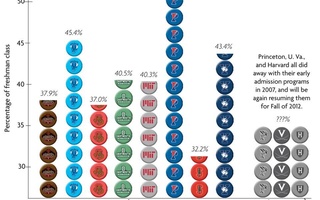While 3.1 percent of the regular decision application pool received an offer of admission from Harvard College last Friday, half of all the admissions offers the College made this year were made three months ago through the early action program. In fact, year’s early action acceptance rate of 21 percent was a record high since the early option was reinstated in 2011. Because an upward trend in early action acceptances entails a downward trend in regular decision acceptances, it is important to acknowledge that early action is playing an increasingly important role in determining the incoming class.
Dean of Admissions and Financial Aid William R. Fitzsimmons ’67 has observed that “the demographic information received so far from the early admits to the Class of 2018 indicated less of a disparity than has existed in years prior.” But early action still remains skewed toward a higher income bracket. This skew in the early acceptances necessitates Harvard put an even greater emphasis on outreach efforts to attract people from all different socioeconomic backgrounds to the early action pool.
When Harvard did away with early action in 2007, we supported the rationale: Early action advantages well-prepared students who tend to be of a higher socioeconomic background and possess more resources. After four years, however, Harvard, along with Princeton and the University of Virginia, decided to restore the early action program. Early action’s reinstatement had much to do with the fact that, according to Dean of the Faculty of Arts and Sciences Michael D. Smith, “many talented students, including some of the best-prepared low-income and underrepresented minority students, were choosing programs with an early-action option, and therefore were missing out on the opportunity to consider Harvard.” While it is evident that some students of lower socioeconomic backgrounds do apply to Harvard through the early action program, there are plenty of others who will not.
In order to further recruit students of diverse backgrounds, last October, Harvard launched the Harvard Connection, a digitally driven initiative. And while Fitzsimmons maintains that “it appears we were successful at least in the first phase in getting the message out to students from poorer economic backgrounds, and from a variety of ethnic backgrounds, and, for that matter, international students,” Harvard should continue to strive to improve outreach strategies and scope of students reached in order to prevent early action from disproportionately advantaging those with more resources.
Read more in Opinion
Blue Is the Most Contentious ColorRecommended Articles
-
Smarter Affirmative ActionA recent study conducted and released by Princeton sociology professor Thomas Espenshade has unearthed alarming racial disparities in the SAT ...
-
UPDATE: Harvard Announces Return of Early Action Admissions ProgramHarvard announced today that its non-binding early action admissions program will return this fall for the Class of 2016.
-
 After Four Year Hiatus, Early Action Admissions Policy To Return to Harvard College This Fall
After Four Year Hiatus, Early Action Admissions Policy To Return to Harvard College This Fall -
(Early) Action Speaks Louder than WordsIf the reinstitution of early action is, in fact, a sincere effort to open the admissions process to a more talented, socioeconomically diverse pool of applicants, then the College’s decision is justified.
-
Mixed Opinions on Early ActionFollowing Harvard’s announcement last week that its early action admissions program would return next fall, undergraduates—except for seniors—at the College seemed to react with a collective shrug, never having an opportunity to apply early to Harvard themselves.
-
Using Early ActionSo far so good for a return to the old way of admissions. Harvard College recently announced that it has received 4,245 applications in its first early action application cycle since 2006.













